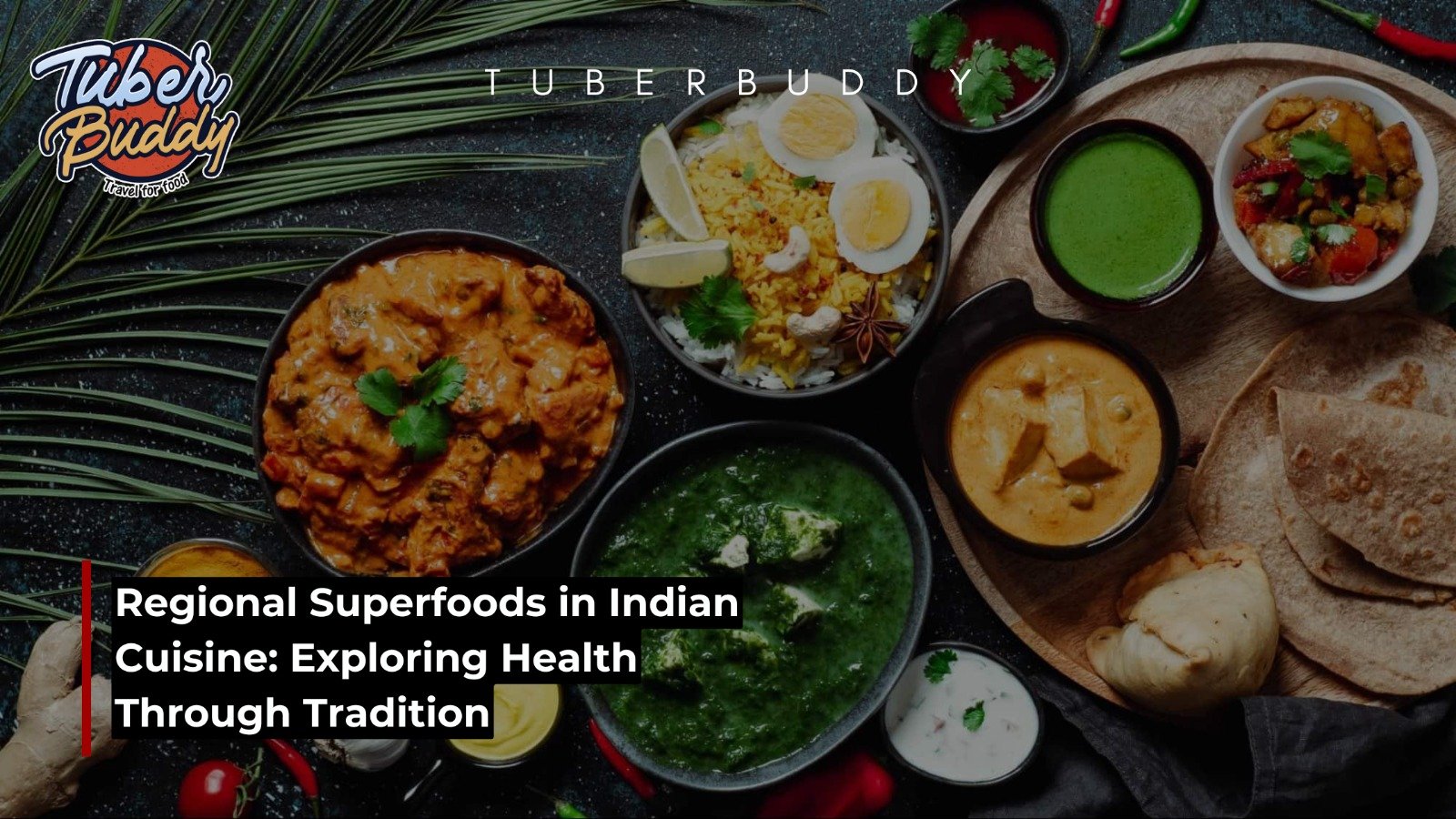Traditional Recipes of India | Authentic Flavors from Every Region

India’s culinary landscape is a vibrant mosaic shaped by geography, climate, and centuries of culture. Each region brings forward its own iconic ingredients—many of which qualify as superfoods. From the snowy peaks of Kashmir to the lush coasts of Kerala, Indian cuisine is not just about satisfying the palate—it’s deeply connected to wellness, seasonal needs, and ancient wisdom.
Let’s explore how each Indian state celebrates good health through its beloved superfoods and time-honored dishes.
Jammu & Kashmir – Patisa & Rogan Josh
The cold, mountainous terrain of Kashmir calls for food that is warming, rich, and flavorful. Patisa is a festive sweet layered with ghee, gram flour, and sugar—known for delivering instant energy and comfort during harsh winters.
Rogan Josh, a signature lamb curry, is slow-cooked with Kashmiri saffron and traditional spices. Saffron, one of the world’s most prized superfoods, aids digestion, uplifts mood, and supports immunity.
Punjab – Pinni & Makki di Roti
Hearty Punjabi cuisine offers nourishment that suits the region’s chilly winters and active lifestyle. Pinni, a nutrient-dense sweet made with wheat flour, ghee, jaggery, and dry fruits, is rich in iron and healthy fats—making it a wholesome energy booster.
Makki di Roti, a cornmeal flatbread, is typically served with Sarson da Saag. Together, they offer a powerful mix of fiber, plant protein, and essential vitamins that support digestive and skeletal health.
Rajasthan – Ghewar & Ker Sangri
Ghewar, a traditional disc-shaped sweet soaked in sugar syrup, is often enjoyed during festivals. When consumed in moderation, its ghee and dairy base can be energy-supportive.
Ker Sangri, a unique desert preparation made from wild berries and dried beans, is loaded with antioxidants, dietary fiber, and the kind of resilience found only in Rajasthan’s arid climate.
Maharashtra – Modak, Poha & Thalipeeth
Modak, an iconic festive sweet, is filled with jaggery and coconut—ingredients known to promote gut health and stabilize blood sugar.
Poha, a quick and light breakfast dish made from flattened rice, turmeric, curry leaves, and peanuts, is rich in iron and easy on the stomach.
Thalipeeth, a multigrain flatbread using jowar, bajra, and besan, delivers a nutritious blend of fiber, plant protein, and slow-digesting carbs.
Gujarat – Basundi & Dhokla
Basundi, a creamy milk-based dessert, offers calcium and energy when made from whole milk and consumed mindfully.
Dhokla, a fermented snack made from gram flour, is light, fluffy, and excellent for gut health. Fermentation enhances digestion and improves nutrient absorption.
Karnataka – Mysore Pak, Bisi Bele Bath & Ragi Mudde
Mysore Pak is a rich, festive sweet prepared with ghee and gram flour—best reserved for special moments.
Bisi Bele Bath blends rice, lentils, tamarind, and seasonal vegetables into a comforting, protein-packed dish that balances flavor and nutrition.
Ragi Mudde, or finger millet balls, are a rural staple loaded with calcium, iron, and amino acids—an ideal food for managing diabetes and strengthening bones.
Uttar Pradesh – Balushahi & Gajar Halwa
Balushahi, a crispy, syrup-soaked sweet, resembles a dense doughnut made from refined flour and ghee—flavorful and rich when eaten occasionally.
Gajar Halwa, a winter favorite made from carrots, milk, and ghee, is brimming with Vitamin A, healthy fats, and antioxidants when prepared with care.
Andhra Pradesh – Pulihora, Punugulu & Ulavacharu
Pulihora, or tamarind rice, combines turmeric, curry leaves, and peanuts to create a tangy, anti-inflammatory meal.
Punugulu are crispy fritters made from fermented urad dal batter. Fermentation enhances their probiotic value and makes them gut-friendly.
Ulavacharu, a spicy horse gram soup, is a traditional superfood rich in plant protein and known for aiding weight management and detoxification.
Odisha – Poda Pitha, Mundi Mansa & Rasagola
Poda Pitha, a slow-baked rice cake with jaggery and coconut, is typically enjoyed during festivals and is high in fiber and natural sweetness.
Mundi Mansa, a curry made with fish head, is a flavorful source of omega-3 fatty acids that promote brain and heart health.
Rasagola, the iconic chenna-based dessert from Odisha, is a light, protein-rich treat that also delivers calcium in every bite.
Kerala – Malabar Biryani, Stew & Palada Payasam
Malabar Biryani is known for its fragrant rice, whole spices, and balanced use of fats—offering a satisfying yet nourishing meal.
Kerala-style vegetable stew, enriched with coconut milk and mild spices, offers a soothing dish that’s gentle on digestion and naturally anti-inflammatory.
Palada Payasam, made from rice flakes and simmered milk, adds a festive and creamy finale rich in calcium and comforting sweetness.
Tamil Nadu – Chettinad Chicken, Rasam & Kootu
Chettinad Chicken Curry is infused with freshly ground spices and herbs that boost metabolism and immunity.
Rasam, a spicy, tangy broth made with tamarind, pepper, and garlic, is traditionally consumed to clear colds, improve digestion, and warm the body.
Kootu, a blend of lentils and seasonal vegetables, delivers plant protein and fiber in a balanced, mildly spiced preparation.
Pan-India Superfoods & Celebratory Dishes
Some Indian snacks transcend state borders and remain household favorites across the country:
Samosas, pakoras, and jalebis are celebratory delights best savored in moderation.
Pani puri, though a street-side snack, uses ingredients like tamarind and spices that can stimulate digestion when prepared hygienically.
Dishes like parotta, chole bhature, and kachori are festive indulgences, usually served with spicy lentil gravies or probiotic-rich pickles that elevate both flavor and digestion.
Conclusion
Traditional Indian cuisine is a treasure trove of superfoods hiding in plain sight. These dishes are not just steeped in flavor but in the health-conscious practices of our ancestors—each recipe crafted to match regional climates, agricultural practices, and seasonal needs.
From the fiber-rich ragi of Karnataka to the probiotic power of fermented snacks in Gujarat, India has always embraced food as medicine—long before wellness trends made it popular.
To know detailed recipes do follow Tuber Buddy blogs page .
